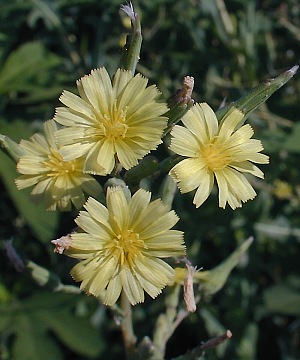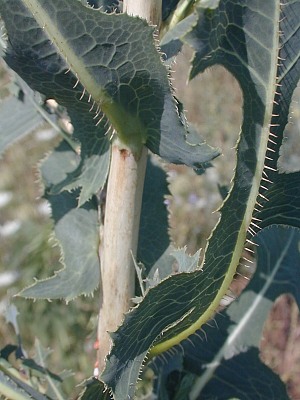Description: This annual or biennial plant is 2-7' tall and unbranched, except where the upper flowering stems occur. The central stem is light green or dull white, glabrous, and round in circumference. There may be a few prickles toward its base. The alternate leaves are up to 12" long and 4" across, becoming smaller as they ascend the stems. They are blue-green, glabrous, and pinnately lobed with a few teeth (however, var. integrata has leaves without lobes). The lobes have a tendency to curve backwards toward the central stem and their tips are pointed. Each leaf has short prickles along its margin and the underside of the central vein. The base of each leaf has a pair of angular lobes that clasp the stem. Both the stems and leaves contain a white milky latex.

Panicles of pale yellow flowerheads are produced
from the central stem and upper side stems. These panicles are rather
long and spreading; they have alternate leaves that are widely spaced
and greatly reduced in size. Each flowerhead is about 1/3" (8 mm.)
across and
about 1/2" in length. It consists of about 20 pale yellow ray florets
and several blue-green bracts underneath. The ray florets have
truncated tips with 5 small teeth, while the overlapping floral bracts
are slender and hairless. The blooming period can occur from mid-summer
to fall; an individual plant will remain in bloom for about a month.
Each floret produces an achene with a thread-like beak that terminates
in a small tuft of white hair. This beak is white and about the same
length as the achene, or slightly longer. The achene is grey or light
brown, oblong with tapering tips, and somewhat flattened with 3-5 fine
nerves on each side. There may be a few teeth near its apex.
Distribution of these achenes is by the wind. The root system consists
of a taproot that is stout and deep. This plant spreads by reseeding
itself.
Cultivation:
Typical growing conditions are full sun and a mesic to dry soil that
can be fertile or somewhat barren. The size of this plant is highly
variable depending on moisture levels and soil fertility. Sometimes
powdery mildew attacks the leaves.

Range & Habitat:
The adventive Prickly Lettuce is a common plant that occurs in every
county of
Illinois (see Distribution
Map). It is native to Eurasia. Habitats include abandoned
fields, fence rows, areas along railroads and
roadsides, vacant lots, dumps, and miscellaneous waste areas. In
Illinois, this plant prefers highly disturbed areas and it doesn't
invade
high quality natural areas to any significant degree. This may be less
true in some of the western and Great Plains states.
Faunal Associations:
The nectar and pollen of the flowerheads attract various kinds of bees.
The caterpillars of a few species of moths eat the foliage, including Cucullia
intermedia (Intermediate Cucullia). The foliage is
bitter-tasting and not a preferred food source for mammalian
herbivores, although cattle and White-tailed Deer occasionally eat it.
Photographic Location:
A vacant lot in Urbana, Illinois.
Comments:
This may be the most common Lactuca sp. (Wild
Lettuce) in Illinois. The prickles on the leaves are somewhat soft and
incapable of tearing flesh and clothing. However, the bruised foliage
emits a bitter rank odor. Another common name for this plant is Wild
Opium
because the latex contains compounds that are mildly sedating and
analgesic. Species of Wild Lettuce fall into one of two large groups:
Those with yellow flowerheads versus those with light blue flowerheads.
Prickly Lettuce belongs to the former group. Prickly Lettuce differs
from Lactuca canadensis (Wild Lettuce) by its
blue-green foliage and the prickles on the undersides of its leaves. It
shares these characteristics with Lactuca saligna
(Willow Lettuce), but this latter species is smaller in size (3' tall
or less), has flowerheads with about 10 ray florets, and has beaks that
are about twice the length of the achenes. Another similar species, the
rare Lactuca ludoviciana (Prairie Lettuce), can
have either blue or yellow flowers. Prairie Lettuce has larger
flowerheads with 20-50 ray florets, and its flattened achenes are black
with only 1-3 nerves on each side.